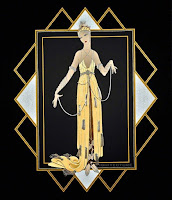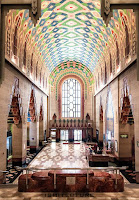Achyut Kanvinde-The Functionalist Architect


 Style Moderne, popular as
the “Art Deco” movement was based on visual arts, architecture and design,
first appeared in France just before World War I. This movement influenced
the buildings, furniture, jewellery, fashion, cars, movies theatres, trains and
everyday objects.
Style Moderne, popular as
the “Art Deco” movement was based on visual arts, architecture and design,
first appeared in France just before World War I. This movement influenced
the buildings, furniture, jewellery, fashion, cars, movies theatres, trains and
everyday objects.
Art Deco was a blend of
modern styles, fine craftsmanship and rich materials which represented luxury,
glamour and exuberant faith in social and technological progress. Rich colours,
bold geometric shapes and lavish ornamentation marked the style. The rise of
new materials and technologies gave way for this style, especially reinforced
concrete. With the discovery of the use of a mesh of iron rods in concrete to
strengthen it and use it to build various buildings, Art Deco started to
flourish as it was easier to make different forms with concrete.
 · 1920s- The
style was first applied to public and commercial buildings. It was rarely used
to designed individual homes but the style adapted well to apartment buildings.
· 1920s- The
style was first applied to public and commercial buildings. It was rarely used
to designed individual homes but the style adapted well to apartment buildings.
· 1930s- Art
Deco became more famous in public work projects, railway stations,
architecture, interior design and amusement parks. The style took over Miami, Florida, producing an area
known as the Art Deco historic district.
· World War II-
The war became the fall of the Art Deco movement and led to lesser use of the
style.
 · Round Corners- Rounded
corners were added to the buildings to give them an aerodynamic, fast and sleek
appearance.
· Round Corners- Rounded
corners were added to the buildings to give them an aerodynamic, fast and sleek
appearance.
· Rule of Threes-
In this style everything came in threes; three windows, three bands or three steps, etc.
· Banding or Racing Stripes- Horizontal
bandings on the façade which were incised or applied in a decorative materials
such as tiles. To emphasize the elements, the bands were painted in a
contrasting colour.
· Columns- Either
whole columns were present standing away from the building or sliced columns
were attached to the front doorway façade which acted as an archway.
 · Glass Block-
Translucent squares of glass were used instead of brick to allow light
penetration and create “ziggurat step” design.
· Glass Block-
Translucent squares of glass were used instead of brick to allow light
penetration and create “ziggurat step” design.
· Ziggurat or Stepped Pediment-
Outlined as a staircase on the roofline of the buildings were formed to
recreate Egyptian motifs.
· Materials-
Stucco, concrete, smooth-faced stone and terracotta were the most famous
materials used. Steel and aluminium were used along with glass blocks and
decorative opaque plate glass.
· Windows-
Usually punctured openings (square or round) were arranged in continuous
horizontal bands filled with decorative glass or glass blocks.
Art
Deco usually combined different styles like Cubism, Bauhaus, Russian
Constructivism and Art Nouveau itself. The articulation was
inspired by designs used by American Indian, Egyptians, early classical
sources as well as nature. The objects were rarely mass-produced but clearly
represented the admiration for the modernity of machines and their inherent
quality of accuracy in designing (symmetry, unvaried repetition of patterns,
simplicity, etc.).
Every style is formed as a result of dissatisfaction
from its predecessor and ends up giving birth to a new style. Same was the
scenario with Art Deco, born as the reaction against Art Nouveau to end the old
conflict between art and industry, and later gave rise to the Modernist
movement.
Your blogs are amazing keep posting such blogs.. ..
ReplyDeleteThank you so much for motivating me:)
DeleteKool stuff buddy, keep going onnnn(no pun intended ;D)
ReplyDeletePun or no pun, your support matters ;)
ReplyDeleteGood content buddy. You really got fantastic skills of writing. Keep posting such informative and knowledgeable blogs. Always waiting for ur stuff on blogs as well as on insta.
ReplyDeleteThank you so much for your constant support :)
ReplyDelete